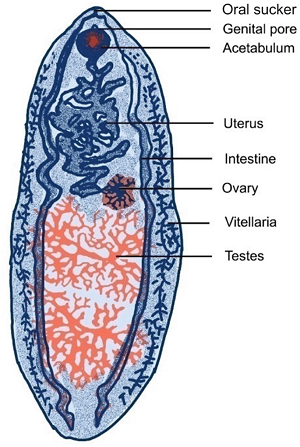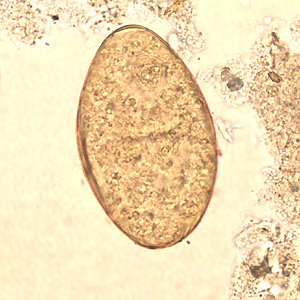Fasciolopsis buski - Classification, Morphology, Manifestation, Transmission
Introduction of Fasciolopsis buski
Fasciolopsis buski is the causative agent of fasciolopsiasis in humans. It is also known as the giant intestinal fluke as it is an exceptionally large parasitic fluke – the largest parasite known to infect humans. It also has veterinary importance as it can also cause infection in pigs.
Also, Fasciolopsis buski is the most common human intestinal trematode causing infection in man.
Classification of Fasciolopsis buski
Kingdom: Animalia
Phylum: Platyhelminthes
Class: Trematoda
Order: Plagiorchiida
Family: Fasciolidae
Genus: Fasciolopsis
Species: F. buski
Habitat of Fasciolopsis buski
The habitat of Fasciolopsis buski is the duodenum and jejunum of pigs and humans where it remains attached to the mucosa.
Morphology of Fasciolopsis buski
The important morphological forms of Fasciolopsis buski include:
Adult worm
Egg
Metacercariae
Adult Worm
adult Fasciolopsis buski measures 2cm to 7.5cm in length, 8mm to 20mm in breadth, and 0.5mm to 3mm thick
the body is elongated and fleshy with a broadly rounded posterior end
two suckers are present- oral sucker and ventral sucker
large ventral sucker measuring 3mm lies close to 0.5mm oral sucker
this morphological form of Fasciolopsis buski resembles Fasciola hepatica but Fasciolopsis buski lacks a cephalic cone, intestinal caeca, and lateral branches
lifespan is around 6 months which is short

Image: Fasciolopsis buski adult morphology (Source: Springer Link)
Egg
eggs of Fasciolopsis buski are large - 130μm to 140μm x 80μm to 85μm
are bile stained and operculated
each adult worm produces 8,000 to 50,000 eggs per day
identical to that of Fasciola hepatica

Image: Fasciolopsis buski egg (Source: CDC)
Infective form
Metacercariae
metacercariae of Fasciolopsis buski is infective to both man and pig
harbors in the freshwater plants
Epidemiology of Fasciolopsis buski
Epidemiology studies for Fasciolopsis buski have confirmed that they occur in China, Taiwan, Thailand, Bangladesh, India, and Indonesia.
Reservoir, Source of Fasciolopsis buski
The main source of Fasciolopsis buski infection is the second intermediate host – such as water caltrops (Trapa bispinosa), water hyacinth (Eichlornia), water chestnut (Eleocharis tuberosa), lotus (Nelumbium), water bamboo (Zizania aquatica) harbor the infective stage (metacercariae)
In most of the world, Pig is the major reservoir host.
Transmission of Fasciolopsis buski
The transmission of Fasciolopsis buski occurs via the following routes:
drinking water contaminated with metacercariae
consumption of aquatic plants raw which is harboring metacercariae – including water caltrops (Trapa bispinosa), water hyacinth (Eichlornia), water chestnut (Eleocharis tuberosa), lotus (Nelumbium), water bamboo (Zizania aquatica)
peeling off with teeth or biting aquatic plants harboring metacercariae
Clinical manifestations of Fasciolopsis buski
Fasciolopsiasis, which clinically manifests as intestinal infection, is caused by Fasciolopsis buski. Although symptoms are absent in most cases, heavy infections do present some syndromes.
Such syndromes include nausea, severe anemia, diarrhea, and epigastric pain.
Complications of Fasciolopsis buski
During the late stage of the disease, asthenia with ascites and anemia may occur.
Prognosis of Fasciolopsis buski
With treatment and supportive therapy, the prognosis of Fasciolopsis buski is very good.